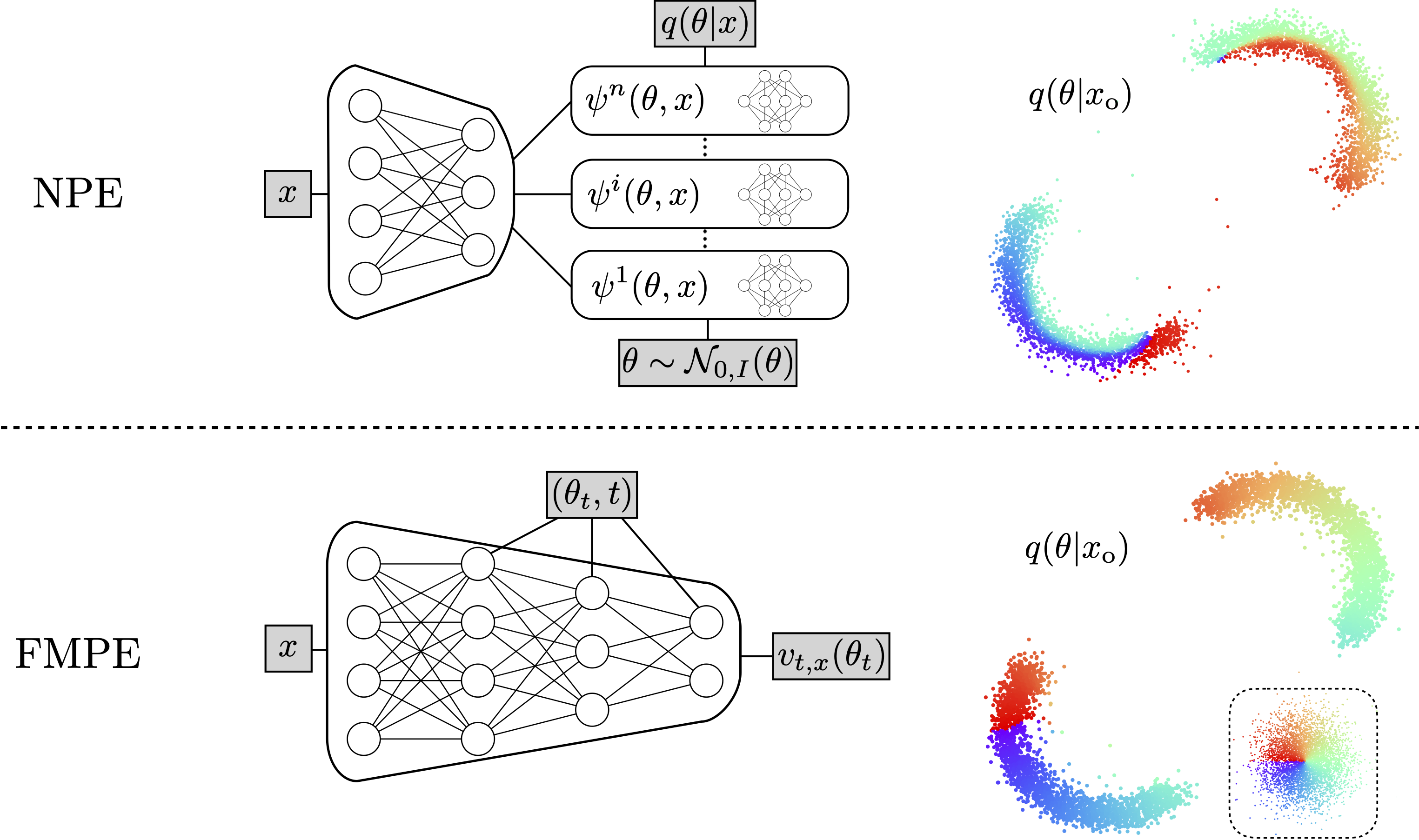This is the companion repository for the NeurIPS-2023 paper Flow Matching for Scalable Simulation Based Inference, which introduces a simulation-based inference (SBI) method based on flow matching, called FMPE. It contains code to run the experiments for an SBI benchmark and gravitational wave inference as a challenging real world example.
This repository builds on the dingo package for the implementation of the base methods for flow matching and the pipeline for the GW experiment.
First, clone the FMPE branch of the
dingo repository.
git clone --branch FMPE https://github.com/dingo-gw/dingo.gitNext, create a new virtual environment.
python3 -m venv fmpe-venv
source fmpe-venv/bin/activateInstall dingo in this environment.
cd dingo
pip install -e ."[dev]"Note that while dingo can in general be installed from
PyPI with pip, this manual installation is required
as the FMPE code is not yet contained in the main branch.
Finally, install the sbibm package for the benchmark experiments.
pip install sbibmTraining and evaluation scripts available in ./sbi-benchmark. To train an FMPE model,
run
python run_sbibm.py --train_dir </path/to/train_dir>where the training directory contains a settings.yaml file. Example settings can be
found in ./sbi-benchmark/settings.yaml.
We here provide a full inference example for the real GW event GW150914. This builds on the full dingo pipeline, although it applies some simplifications (e.g., no full noise conditioning).
This example follows the steps from the
dingo NPE tutorial.
To run this, navigate to the ./gravitational_waves directory and follow the
instructions below.
We first generate a dataset of GW polarizations, which is later used to train the model.
dingo_generate_dataset --settings datasets/waveform_dataset_settings.yaml --out_file
datasets/waveform_dataset.hdf5 --num_processes 8The number of processes should be adjusted to the number of available CPU cores.
To train Dingo, one needs to provide an estimate for the detector noise amplitude
spectral density (ASD). For simplicity, we provide a dataset in
./datasets/asd_dataset_GW150914.hdf5, so this step can be skipped.
Once the datasets are available, we train the FMPE network.
dingo_train --settings_file training/train_settings.yaml --train_dir trainingDepending on the available resources some settings may need to be adjusted. This includes
model/...for the size of the model,local/num_workersfor number of workers (set this to number of available CPU cores -1; dingo requires some heavy preprocessing, so if this number is too low, it may become the bottleneck),local/devicefor the accelerator (typicallycuda,cpuis also possible, but extremely slow) andtraining/stage_0/batch_sizefor the batch size (reduce this if you run out of memory).
Please also refer to the documentation: https://dingo-gw.readthedocs.io.
@inproceedings{wildberger2023flow,
title={Flow Matching for Scalable Simulation-Based Inference},
author={Jonas Bernhard Wildberger and Maximilian Dax and Simon Buchholz and Stephen R Green and Jakob H. Macke and Bernhard Sch{\"o}lkopf},
booktitle={Thirty-seventh Conference on Neural Information Processing Systems},
year={2023},
url={https://openreview.net/forum?id=D2cS6SoYlP},
eprint={2305.17161},
archivePrefix={arXiv},
primaryClass={cs.LG},
}If you use the dingo code for the GW example, please also cite the following (and refer to the Reference section of the dingo README for other optional citations).
@article{Dax:2021tsq,
author = {Dax, Maximilian and Green, Stephen R. and Gair, Jonathan and Macke, Jakob H. and Buonanno, Alessandra and Sch\"olkopf, Bernhard},
title = "{Real-Time Gravitational Wave Science with Neural Posterior Estimation}",
eprint = "2106.12594",
archivePrefix = "arXiv",
primaryClass = "gr-qc",
reportNumber = "LIGO-P2100223",
doi = "10.1103/PhysRevLett.127.241103",
journal = "Phys. Rev. Lett.",
volume = "127",
number = "24",
pages = "241103",
year = "2021"
}